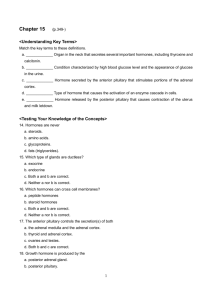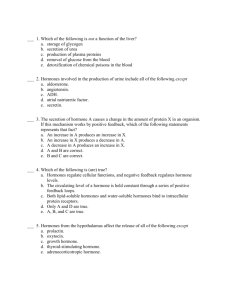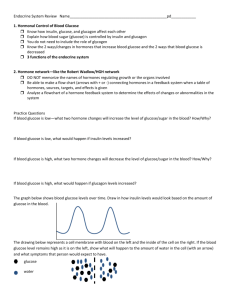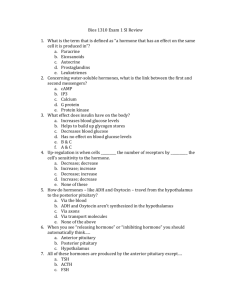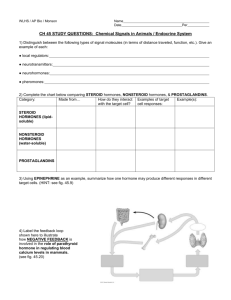The Endocrine System
advertisement
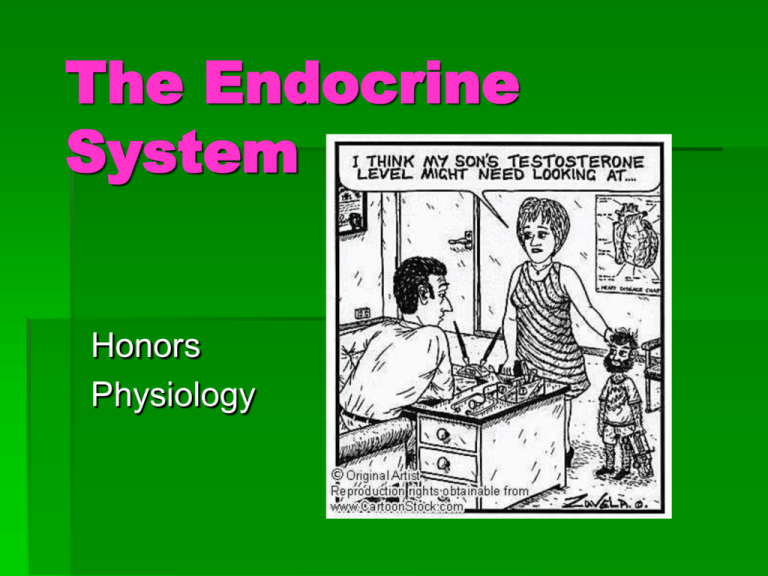
The Endocrine System Honors Physiology What are hormones? Hormones: send messages act locally or at a distance work quickly or slowly can be created/excreted by cells, tissues or organs, collectively known as “glands” secreted via epithelial cells extracellular fluid blood stream receptors on target cells ducts are not used by endocrine system Comparison to Nervous System Fig. 13.2 Comparison to Nervous System Entity Cell type Chemical signal Specificity of response Speed Length of effect Nervous Sys Endocrine Sys Neurons Epithelial Neurotransmitter Hormone Receptors on postsynaptic cell Receptors on target cells Milliseconds Seconds to hours Brief Brief or long Example of Hormonal Regulation—Today’s Lab Thyroxine Released from thyroid gland Target: cells all over body Influences metabolism Thyroid stimulating hormone (TSH) Released from anterior pituitary gland Target: thyroid gland Signal: “release thyroid hormones!” Endocrine System—Relative Stability of Hormone Concentrations Negative feedback maintains stable hormone levels Fig. 13.11 Endocrine System—3 Ways To Control Hormonal Secretions Fig. 13.8 Example: Negative Feedback Controls Blood Glucose Levels What happens when your blood glucose gets too low? Fig 13.36 Example: Negative Feedback Controls Blood Glucose Levels What happens when your blood glucose gets too high? Fig 13.36 Steroid Hormones Fig. 13.5 Steroid Hormones Lipid soluble Receptor in the nucleus binds hormone gene transcription mRNA is then translated into a protein in the cytoplasm Examples estrogen, testosterone aldosterone, cortisol Nonsteroid Hormones Fig. 13.7 Nonsteriod Hormones Cannot move through lipid bilayer Instead they bind to receptors in cell membrane Examples: TSH Epinephrine Glucagon Hypothalamus Regulates other glands to tell them when to release their hormones Fig. 13.9 Pituitary Gland Fig. 13.9 Anterior Pituitary Adrenocorticotropic hormone (ACTH) Target: adrenal cortex, stimulates cortisol release influences protein and fat metabolism Gonadotropins follicle stimulating hormone (FSH) egg or sperm maturation For egg, stimulates release of egg from follicle mid cycle luteinizing hormone (LH) Stimulates release of sex hormones Anterior Pituitary cont. Growth Hormone (GH) bone growth/osteogenesis Melanocyte Stimulating Hormone (MSH) skin color, includes tanning Prolactin (PRL) lactation Thyroid Stimulating Hormone (TSH) stimulates thyroid secretions Robert P. Wadlow 8’ 11” Yikes, his anterior pituitary released too much growth hormone! Age Height 8 6’ 14 7’5” 18 8’4” 22 8’11” Anterior Pituitary cont. How am I going to remember all of this??? A Green Giant Makes PRetty Things ACTH Gonadotropins (FSH, LH/ICSH) GH MSH PR TSH Posterior Pituitary Antidiuretic Hormone (ADH) decreases urine formation when you are dehydrated, your body says “don’t lose water!”, so ADH is increased increased ADH = concentrated urine Oxytocin smooth muscle contractions in the uterus during childbirth Recent studies = “bonding” hormone Posterior Pituitary cont. Why do you urinate more when you drink caffeine? Your body recognizes caffeine as a toxin that it needs to expel from the body Caffeine is a diuretic – it makes you urinate it inhibits secretion of ADH you don’t get the “don’t lose water!” signal so you expel more water to try and flush out the toxin Pineal Gland Melatonin Helps regulate circadian rhythms (sleepwake cycle) Thyroid Thyroxine or tetraiodothyronine (T4)-and Triiodothyronine (T3) regulate your food metabolism (break down glucose, fat & protein to create energy) increase temperature, growth and development Fig. 13.16 Thyroid & Parathyroid Thyroid releases Calcitonin lowers calcium levels in the blood Parathyroid releases Parathyroid Hormone (PTH) Fig. 13.24 increases calcium levels in the blood Pancreas Insulin Glucagon Islets of Langerhans regulate blood glucose levels Both hormones created in the… Fig. 13.34 Pancreas cont. Islets of Langerhans Alpha Cells Make Glucagon Released when your blood sugar levels get low Increases blood glucose levels by breaking down glycogen (storage form of glucose in the liver) and noncarbohydrates into glucose Beta Cells Make Insulin Released when your blood sugar levels get high Tells your body cells to take sugar in, and decreases blood glucose levels by stimulating the liver to form glycogen Pancreas cont. Diabetes- can’t regulate your blood glucose Type I - Juvenile Islets of Langerhans don’t work properly & cannot create sufficient insulin (or glucagon) usually need insulin injections (why not glucagon injections?) usually inherited Type II - Adult onset Insulin receptors throughout body don’t work properly usually can use oral treatment related to weight gain About 17 million people in the US have diabetes! Adrenal Glands Adrenal Medulla epinephrine/adrenalin Fig. norepinephrine/noradrenalin 13.28 Increases blood glucose, heart rate, etc. Blood vessels constrict in digestive tract and kidneys, dilate in blood vessels of the muscles Adrenal Glands cont. Adrenal Cortex Aldosterone Target cells in kidneys Maintain Na+ and K+ balance Cortisol Glucose, protein and fat metabolism Anti inflammatory Androgens supplement gonad sex hormones Reproductive Organs Ovaries Estrogen stimulates egg maturation secondary female sex characteristics Progesterone maintains uterine lining in case of implantation Testes Testosterone regulates spermatogenesis secondary male sex characteristics Adrenal Glands cont. Addison disease Cortisol hyposecretion low Na+, high K +, dehydration, low glucose, can be very serious Cushing syndrome Cortisol hypersecretion (usually by too much ACTH) High Na+, low K+, high glucose, water retention Thyroid cont. Grave’s disease too much hormone Hyperthyroidism Hashimoto’s disease too little hormone Hypothyroidism


